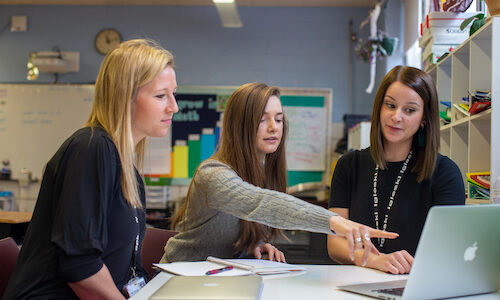
What’s the difference between an athlete who wins a race and one who finishes among the rest of the pack? It might be technique, practice time, nutrition, or motivation. It’s likely a combination of factors, but one that’s undeniable is the relationship of the athlete with their coach. The best athletes inevitably have the best coaching relationships: relationships that have been built intentionally to help the athletes progress further toward specific goals.
While educators aren’t athletes, they work long hours toward goals that can get lost amid the daily setbacks and struggles they encounter. And just like athletes, educators require effective coaches throughout their careers.
Where did all the coaches go?
We are currently experiencing some of the highest teacher attrition rates in modern times, especially in urban or high-poverty areas, where turnover rates are 19–29%, resulting in many schools becoming “bottom heavy” as experienced educators retire or transition into other careers. These attrition rates over the last several years have left many schools with fewer than half of their teachers having greater than five years of teaching experience.
The loss of pandemic-related funding and a shortage of qualified teachers to hire has led many districts to cut, or greatly reduce, the number of instructional coaches, the individuals most directly involved with supporting educators in meeting their goals. So, what’s an educator to do when they discover they don’t have a coach?
Autonomy in finding your own a coach
As a teacher, you may often feel you have coaching done to you. For example, your students’ scores aren’t where they should be, so an administrator informs you you’ll be part of a coaching cycle the following term.
This is directly opposed to athletes, who seek out coaches whom they feel can help them meet their performance goals. Educators can—and should—do the same thing. Because when we have autonomy in choosing our coaches, selecting the focus of coaching, and determining the methods used to achieve our goals, we are more likely to meet our goals and have a greater impact on student learning.
Step 1: Find a coach, or create one
Is there someone in your building or district who teaches a different content area and whom you admire? Ask them if you can take a learning walk together to explore what you admire most in their teaching or strategies. If no one comes immediately to mind, consider asking yourself the following questions:
- What are students saying about other teachers?
- Who’s most impactful?
- Are there any educators I’ve met through professional development workshops, or district-supported events, with whom I felt I shared common goals and who were excited about improving student learning?
If you can’t seem to find anyone within your school or district, you may want to connect with another educator online who shares content that you’d like to try with your students. Or you might find someone who has commented on educational posts that also resonated for you. Reach out and build a collaborative network.
Still can’t find a coach or coach-like colleague? NWEA has a team of instructional coaches who work with educators throughout a coaching cycle to support them. NWEA instructional coaches help educators select a coaching focus, identify and learn strategies to achieve a chosen goal, use protocols for assessing educators’ and students’ progress toward the selected goal, and celebrate success at the completion of a coaching cycle. Coaching can be done virtually or onsite and remains independent from school and district evaluation processes.
Step 2: Reflect
After observing colleagues plan and teach lessons, take time to analyze instructional delivery, student engagement, and classroom management. Self-assess your own skills in these areas by recording and reviewing video of your own instruction. You can use a rubric or framework to be as objective as possible in your analysis.
When you’re ready, share your recorded lessons with your selected coach/colleague for constructive feedback. Your analysis should give you a list of areas in which you’d like to grow.
Step 3: Build your knowledge base
Follow blogs, podcasts, or YouTube channels by educational leaders you admire for insights into instructional strategies with the greatest impact on student learning. John Hattie’s Visible Learning study can help you narrow down the strategies you’d like to learn more about and begin implementing in your classroom.
Include in your research how you will track the impact on student learning. Not all evidence-collection methods are appropriate for all instructional areas or student groups.
Step 4: Take action
Implement the strategy you have identified and researched. Track the impact on student learning and be ready to adapt your methods based on what works best for your students and what the data is telling you.
Don’t be afraid to record yourself, even if you are the only one who watches the replay. Remember that even a small change is a step in the improvement process: when repeated, a small change can have a significant impact.
Step 5: Circle back and reassess
Through the use of formative or interim assessments, discover where your changes are having an impact on student learning. Then, reevaluate your original goal. Have you met or surpassed your goal and, if so, what comes next? If not, what other strategies might you need to try?
Ask your coach or a trusted colleague to observe you (again) and provide further constructive feedback related specifically to the strategy you’ve tried putting into place. You can even solicit student feedback at this point. What seems to be helping or limiting their progress? Brief exercises such as exit tickets covering both the content taught and the strategy used can help gauge student understanding and their learning experience, allowing you to adjust future lessons accordingly.
Step 6: Celebrate growth
As educators, we know to prioritize growth in student learning versus focusing only on student achievement. But do we remember to celebrate our own growth in the same way?
You are a work in progress and so is your teaching practice. The only way we improve at anything is through consistent re-evaluation of our process and outcomes (see step 5). We need to be sure to take time to see small successes along the way. Through the use of ongoing assessment, we can spot progress as it’s happening.
Practice, practice, practice
When we release ourselves from the idea that our teaching skills are fixed, we can begin to expand our practice through development in our chosen areas. Just as athletes rely on coaches to fine-tune their skills, educators can seek to support and structure their growth journey.
Even when formal coaching is not available, educators can thrive by taking ownership of their professional growth. By seeking out peer mentors, engaging in self-reflection, building knowledge through research, and actively implementing and reassessing new strategies, teachers can drive their development. Celebrating small wins and tracking progress ensure that both student learning and professional development remain a priority, even when external coaching resources are limited.
Professional learning is something we do for ourselves, our practice, and our students, instead of merely something that’s done to or for us.



